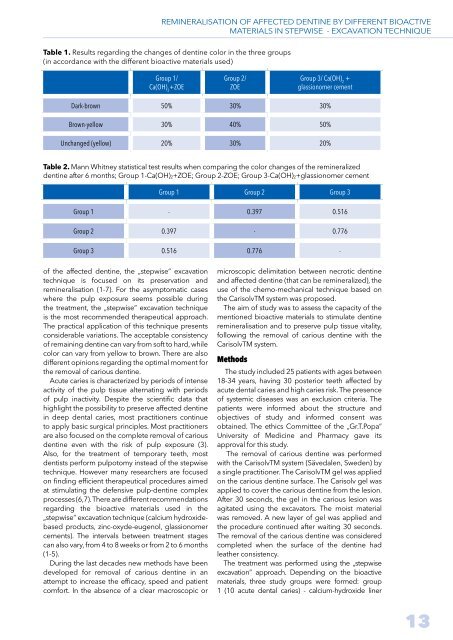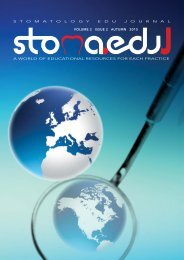STOMATOLOGY EDU JOURNAL 1-2014
You also want an ePaper? Increase the reach of your titles
YUMPU automatically turns print PDFs into web optimized ePapers that Google loves.
REMINERALISATION OF AFFECTED DENTINE BY DIFFERENT BIOACTIVE<br />
MATERIALS IN STEPWISE - EXCAVATION TECHNIQUE<br />
Table 1. Results regarding the changes of dentine color in the three groups<br />
(in accordance with the different bioactive materials used)<br />
Group 1/<br />
Ca(OH) 2<br />
+ZOE<br />
Group 2/<br />
ZOE<br />
Group 3/ Ca(OH) 2<br />
+<br />
glassionomer cement<br />
Dark-brown 50% 30% 30%<br />
Brown-yellow 30% 40% 50%<br />
Unchanged (yellow) 20% 30% 20%<br />
Table 2. Mann Whitney statistical test results when comparing the color changes of the remineralized<br />
dentine after 6 months; Group 1-Ca(OH) 2+ZOE; Group 2-ZOE; Group 3-Ca(OH) 2+glassionomer cement<br />
Group 1 Group 2 Group 3<br />
Group 1 - 0.397 0.516<br />
Group 2 0.397 - 0.776<br />
Group 3 0.516 0.776 -<br />
of the affected dentine, the „stepwise” excavation<br />
technique is focused on its preservation and<br />
remineralisation (1-7). For the asymptomatic cases<br />
where the pulp exposure seems possible during<br />
the treatment, the „stepwise” excavation technique<br />
is the most recommended therapeutical approach.<br />
The practical application of this technique presents<br />
considerable variations. The acceptable consistency<br />
of remaining dentine can vary from soft to hard, while<br />
color can vary from yellow to brown. There are also<br />
different opinions regarding the optimal moment for<br />
the removal of carious dentine.<br />
Acute caries is characterized by periods of intense<br />
activity of the pulp tissue alternating with periods<br />
of pulp inactivity. Despite the scientific data that<br />
highlight the possibility to preserve affected dentine<br />
in deep dental caries, most practitioners continue<br />
to apply basic surgical principles. Most practitioners<br />
are also focused on the complete removal of carious<br />
dentine even with the risk of pulp exposure (3).<br />
Also, for the treatment of temporary teeth, most<br />
dentists perform pulpotomy instead of the stepwise<br />
technique. However many researchers are focused<br />
on finding efficient therapeutical procedures aimed<br />
at stimulating the defensive pulp-dentine complex<br />
processes (6,7). There are different recommendations<br />
regarding the bioactive materials used in the<br />
„stepwise” excavation technique (calcium hydroxidebased<br />
products, zinc-oxyde-eugenol, glassionomer<br />
cements). The intervals between treatment stages<br />
can also vary, from 4 to 8 weeks or from 2 to 6 months<br />
(1-5).<br />
During the last decades new methods have been<br />
developed for removal of carious dentine in an<br />
attempt to increase the efficacy, speed and patient<br />
comfort. In the absence of a clear macroscopic or<br />
microscopic delimitation between necrotic dentine<br />
and affected dentine (that can be remineralized), the<br />
use of the chemo-mechanical technique based on<br />
the CarisolvTM system was proposed.<br />
The aim of study was to assess the capacity of the<br />
mentioned bioactive materials to stimulate dentine<br />
remineralisation and to preserve pulp tissue vitality,<br />
following the removal of carious dentine with the<br />
CarisolvTM system.<br />
Methods<br />
The study included 25 patients with ages between<br />
18-34 years, having 30 posterior teeth affected by<br />
acute dental caries and high caries risk. The presence<br />
of systemic diseases was an exclusion criteria. The<br />
patients were informed about the structure and<br />
objectives of study and informed consent was<br />
obtained. The ethics Committee of the „Gr.T.Popa”<br />
University of Medicine and Pharmacy gave its<br />
approval for this study.<br />
The removal of carious dentine was performed<br />
with the CarisolvTM system (Sävedalen, Sweden) by<br />
a single practitioner. The CarisolvTM gel was applied<br />
on the carious dentine surface. The Carisolv gel was<br />
applied to cover the carious dentine from the lesion.<br />
After 30 seconds, the gel in the carious lesion was<br />
agitated using the excavators. The moist material<br />
was removed. A new layer of gel was applied and<br />
the procedure continued after waiting 30 seconds.<br />
The removal of the carious dentine was considered<br />
completed when the surface of the dentine had<br />
leather consistency.<br />
The treatment was performed using the „stepwise<br />
excavation” approach. Depending on the bioactive<br />
materials, three study groups were formed: group<br />
1 (10 acute dental caries) - calcium-hydroxide liner<br />
13



